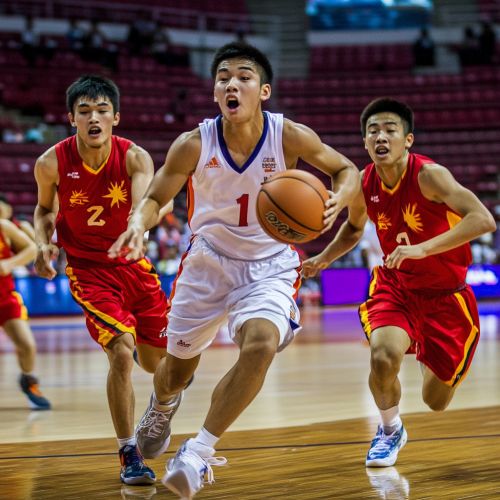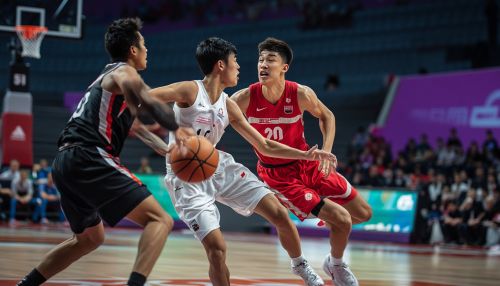Basketball at the Asian Games: Difference between revisions
(Created page with "== History of Basketball at the Asian Games == Basketball has been a regular feature at the Asian Games since its introduction in 1951. The sport has grown significantly in popularity and competitiveness across the continent, with numerous countries participating and showcasing their talents. The Asian Games, organized by the Olympic Council of Asia, have provided a platform for Asian basketball teams to compete at a high level, fostering the development of the...") |
No edit summary |
||
| Line 39: | Line 39: | ||
* [[Chinese Basketball Association]] | * [[Chinese Basketball Association]] | ||
[[Image:Detail-98085.jpg|thumb|center|Players in action during a basketball game at the Asian Games.|class=only_on_mobile]] | |||
[[Image:Detail-98086.jpg|thumb|center|Players in action during a basketball game at the Asian Games.|class=only_on_desktop]] | |||
[[Category:Basketball]] | [[Category:Basketball]] | ||
[[Category:Asian Games]] | [[Category:Asian Games]] | ||
[[Category:Sports in Asia]] | [[Category:Sports in Asia]] | ||
Latest revision as of 17:34, 23 September 2024
History of Basketball at the Asian Games
Basketball has been a regular feature at the Asian Games since its introduction in 1951. The sport has grown significantly in popularity and competitiveness across the continent, with numerous countries participating and showcasing their talents. The Asian Games, organized by the Olympic Council of Asia, have provided a platform for Asian basketball teams to compete at a high level, fostering the development of the sport in the region.
Early Years (1951-1970)
The first appearance of basketball at the Asian Games was in 1951 in New Delhi, India. During this period, the sport was dominated by teams from the Philippines and Japan. The Philippines won the inaugural tournament, setting a precedent for their strong performance in subsequent games. Japan also emerged as a formidable contender, often finishing in the top ranks.
Growth and Development (1970-1990)
The 1970s and 1980s saw the emergence of new basketball powerhouses in Asia. China, in particular, began to assert its dominance in the sport. The Chinese men's team won their first gold medal at the 1978 Bangkok Asian Games and continued to be a dominant force in subsequent editions. The women's basketball competition was introduced in 1974, with South Korea and China frequently battling for supremacy.
Modern Era (1990-Present)
In the modern era, the level of competition in basketball at the Asian Games has intensified. Countries such as Iran, South Korea, and Chinese Taipei have made significant strides, challenging the traditional dominance of China and the Philippines. The introduction of professional leagues in many Asian countries has contributed to the overall improvement in the quality of play.
Format and Rules
The basketball competition at the Asian Games follows the rules and regulations set by the International Basketball Federation (FIBA). The tournament typically features a preliminary round, followed by knockout stages leading to the finals. Both men's and women's tournaments are held, with teams divided into groups for the initial phase of the competition.
Notable Performances and Records
Several players and teams have left an indelible mark on the history of basketball at the Asian Games. The Chinese men's team holds the record for the most gold medals, while the South Korean women's team has been particularly successful in their category. Individual players such as Yao Ming and Jin Lipeng have also made significant contributions to their teams' successes.
Impact on Asian Basketball
The Asian Games have played a crucial role in the development of basketball in Asia. The competition has provided a platform for emerging talents and has helped raise the profile of the sport across the continent. The exposure and experience gained by participating teams have contributed to the growth of professional leagues and the overall improvement in the standard of basketball in Asia.
Future Prospects
Looking ahead, basketball at the Asian Games is expected to continue its growth trajectory. With increasing investment in sports infrastructure and development programs, more countries are likely to emerge as strong contenders. The popularity of the sport is also expected to rise, driven by the success of Asian players in international leagues and competitions.
See Also
- Olympic Council of Asia
- International Basketball Federation
- Yao Ming
- Philippine Basketball Association
- Chinese Basketball Association


